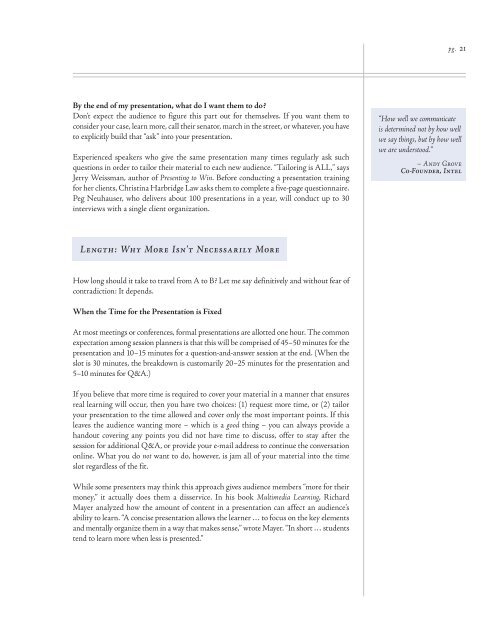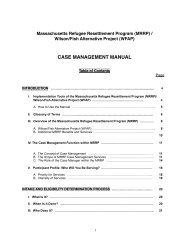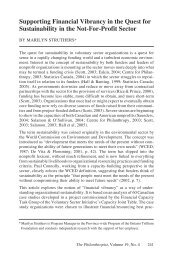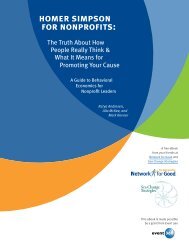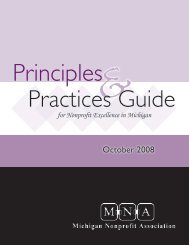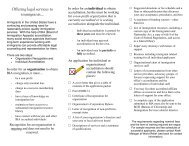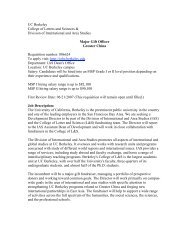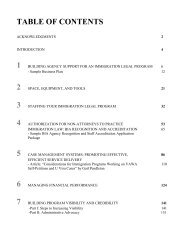Why Bad Presentations Happen to Good Causes - The Goodman ...
Why Bad Presentations Happen to Good Causes - The Goodman ...
Why Bad Presentations Happen to Good Causes - The Goodman ...
You also want an ePaper? Increase the reach of your titles
YUMPU automatically turns print PDFs into web optimized ePapers that Google loves.
By the end of my presentation, what do I want them <strong>to</strong> do?<br />
Don’t expect the audience <strong>to</strong> figure this part out for themselves. If you want them <strong>to</strong><br />
consider your case, learn more, call their sena<strong>to</strong>r, march in the street, or whatever, you have<br />
<strong>to</strong> explicitly build that “ask” in<strong>to</strong> your presentation.<br />
Experienced speakers who give the same presentation many times regularly ask such<br />
questions in order <strong>to</strong> tailor their material <strong>to</strong> each new audience. “Tailoring is ALL,” says<br />
Jerry Weissman, author of Presenting <strong>to</strong> Win. Before conducting a presentation training<br />
for her clients, Christina Harbridge Law asks them <strong>to</strong> complete a five-page questionnaire.<br />
Peg Neuhauser, who delivers about 100 presentations in a year, will conduct up <strong>to</strong> 30<br />
interviews with a single client organization.<br />
Length: <strong>Why</strong> More Isn’t Necessarily More<br />
How long should it take <strong>to</strong> travel from A <strong>to</strong> B? Let me say definitively and without fear of<br />
contradiction: It depends.<br />
When the Time for the Presentation is Fixed<br />
At most meetings or conferences, formal presentations are allotted one hour. <strong>The</strong> common<br />
expectation among session planners is that this will be comprised of 45–50 minutes for the<br />
presentation and 10–15 minutes for a question-and-answer session at the end. (When the<br />
slot is 30 minutes, the breakdown is cus<strong>to</strong>marily 20–25 minutes for the presentation and<br />
5–10 minutes for Q&A.)<br />
If you believe that more time is required <strong>to</strong> cover your material in a manner that ensures<br />
real learning will occur, then you have two choices: (1) request more time, or (2) tailor<br />
your presentation <strong>to</strong> the time allowed and cover only the most important points. If this<br />
leaves the audience wanting more – which is a good thing – you can always provide a<br />
handout covering any points you did not have time <strong>to</strong> discuss, offer <strong>to</strong> stay after the<br />
session for additional Q&A, or provide your e-mail address <strong>to</strong> continue the conversation<br />
online. What you do not want <strong>to</strong> do, however, is jam all of your material in<strong>to</strong> the time<br />
slot regardless of the fit.<br />
While some presenters may think this approach gives audience members “more for their<br />
money,” it actually does them a disservice. In his book Multimedia Learning, Richard<br />
Mayer analyzed how the amount of content in a presentation can affect an audience’s<br />
ability <strong>to</strong> learn. “A concise presentation allows the learner … <strong>to</strong> focus on the key elements<br />
and mentally organize them in a way that makes sense,” wrote Mayer. “In short … students<br />
tend <strong>to</strong> learn more when less is presented.”<br />
pg. 21<br />
“How well we communicate<br />
is determined not by how well<br />
we say things, but by how well<br />
we are unders<strong>to</strong>od.”<br />
– Andy Grove<br />
Co-Founder, Intel


